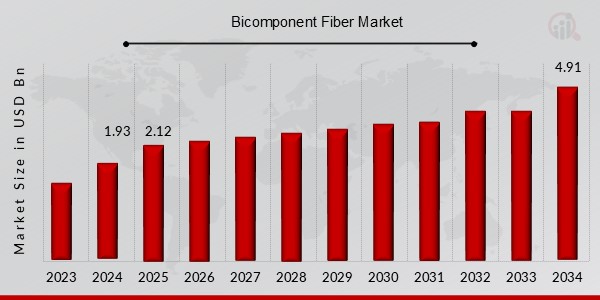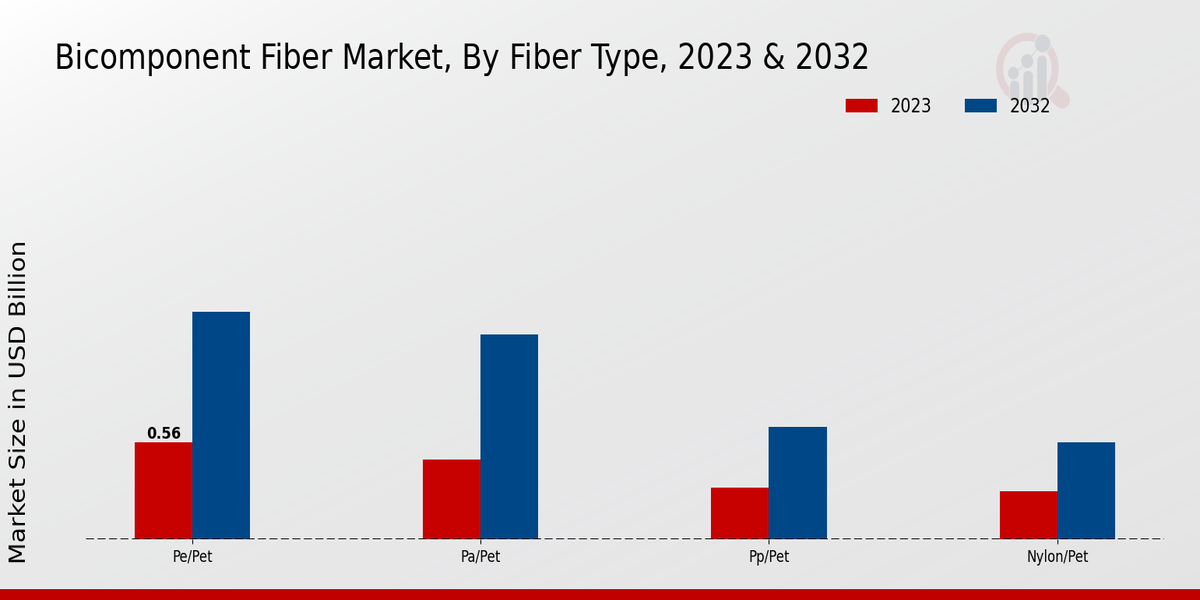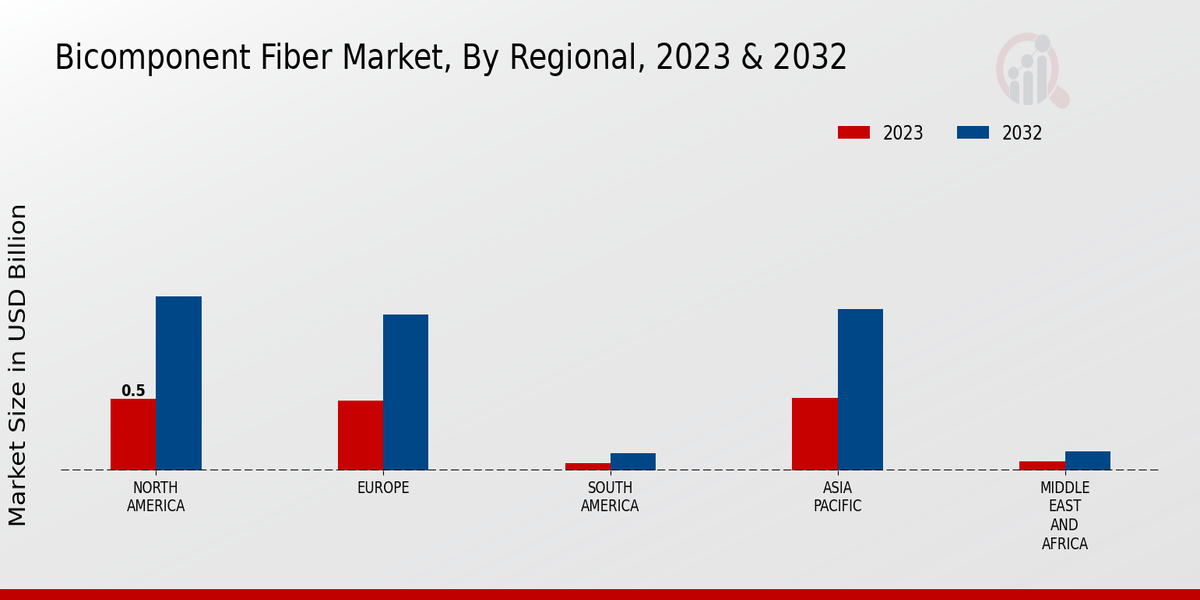Global Bicomponent Fiber Market Overview
The Bicomponent Fiber Market Size was estimated at 1.93 (USD Billion) in 2024. The Bicomponent Fiber Industry is expected to grow from 2.12 (USD Billion) in 2025 to 4.91 (USD Billion) by 2034. The Bicomponent Fiber Market CAGR (growth rate) is expected to be around 9.80% during the forecast period (2025 - 2034).
Key Bicomponent Fiber Market Trends Highlighted
Key market drivers include increasing demand for lightweight and durable materials in various industries, such as automotive, aerospace, and construction. Growing environmental concerns and the need for sustainable solutions are also driving the market.Opportunities for growth in the bicomponent fiber market lie in the development of new applications and the expansion into emerging markets. Recent trends highlight the rise of bio-based bicomponent fibers, which offer environmentally friendly alternatives to traditional materials.Market research indicates a surge in demand for bicomponent fibers with unique properties, such as enhanced strength, elasticity, and moisture management. This demand is driven by the increasing popularity of performance-oriented products in sportswear, activewear, and medical textiles. The adoption of advanced technologies, such as nanotechnology and functionalization, is further expanding the capabilities of bicomponent fibers, creating opportunities for innovation and value creation.

Source: Primary Research, Secondary Research, MRFR Database and Analyst Review
Bicomponent Fiber Market Drivers
Rising Demand for Nonwoven Fabrics
Bicomponent fibers are extensively used in the production of nonwoven fabrics, which are witnessing increasing demand across various end-use industries. Nonwoven fabrics offer unique properties such as softness, absorbency, and breathability, making them suitable for applications in hygiene products, medical textiles, and filtration systems. The growing demand for nonwoven fabrics is expected to drive the growth of the bicomponent fiber market in the coming years.The Bicomponent Fiber Market Industry is expected to grow significantly in the coming years, driven by increasing demand for nonwoven fabrics, advancements in technology, and expanding applications in diverse industries.
Advancements in Production Technology
Technological advancements in the production of bicomponent fibers are enabling manufacturers to develop fibers with enhanced properties and reduced costs. New spinning techniques and the use of innovative materials are resulting in the production of bicomponent fibers with improved strength, elasticity, and durability. These advancements are expected to expand the application scope of bicomponent fibers and drive market growth.
Expanding Applications in Diverse Industries
Bicomponent fibers originally created for use in textiles are nowadays used in an ever-increasing number of industries. Specifically, this product is used in the automotive industry for creating various parts of the interior, in filtration, and in production of various medical devices. This tendency is caused by the unique characteristics of bicomponent fibers. They are able to unite different materials and reach the desired specifications. It is likely that this process will continue and, as a result, the Bicomponent Fiber Market Industry will grow.
Bicomponent Fiber Market Segment Insights
Bicomponent Fiber Market Fiber Type Insights
The Bicomponent Fiber Market segmentation by Fiber Type includes PE/PET, PA/PET, PP/PET, Nylon/PET, and Others. The PE/PET segment held the largest market share in 2023, with an approximate 35% share. The growth of the segment can be ascribed to the increased demand for PE/PET fibers, with rising sales for their application in the production of nonwoven fabrics. Nonwoven fabrics are widely used throughout consumer markets, in products such as wipes, diapers, and medical textiles. The PA/PET segment is expected to show the highest growth rate during the forecast period.This is due to the increasing use of PA/PET fibers in the production of automotive parts. The fibers are highly strong as well as resistant to chemicals and wear. The PP/PET segment is also expected to grow at a stable rate, with the increasing use of the fibers in marine applications, such as those used to produce ropes, nets, and other related items. The Nylon/PET segment is expected to grow at the slowest pace. Nylon/PET fibers are used throughout the textile industry in the production of a variety of products, owing to a combination of high strength, exceptional elasticity, and resistance to moisture.The Others segment includes a variety of bicomponent fibers made of different types of polymer. They are utilized in other, more bespoke applications as well. The overall Bicomponent Fiber Market is expected to grow at a stable pace during the forecast timeline. It is anticipated to be worth around USD 3.7 billion by 2032, growing at a CAGR of around 9.8%.

Source: Primary Research, Secondary Research, MRFR Database and Analyst Review
Bicomponent Fiber Market Application Insights
The Bicomponent Fiber Market is segmented by Application into Nonwovens, Apparel, Automotive, Medical, and Packaging. The Nonwovens segment is expected to be the largest market share in 2023. These fibers are used in the production of nonwoven products including wipes, diapers, and others. The Apparel segment is expected to be one of the fastest growing with the increasing use of bicomponent fibers in athleisure and sportswear. The Automotive segment is expected to grow at a steady rate as these fibers are used for the production of car interior, filters, and others.The Medical segment is expected to grow as these fibers are used for the manufacturing of medical devices, wound dressing, and others. The Packaging segment is expected to grow at a moderate rate as these fibers are used for the production of food packaging, beverage packaging, and others.
Bicomponent Fiber Market End-use Industry Insights
The Bicomponent Fiber Market is segmented into various end-use industries, including Construction, Agriculture, Healthcare, Consumer Goods, and Transportation. Each segment offers unique growth opportunities and challenges for Bicomponent Fiber manufacturers. The Construction segment is expected to witness significant growth in the coming years, driven by the increasing demand for lightweight and durable materials in residential and commercial buildings. Bicomponent Fibers are used in roofing, flooring, and insulation applications, offering advantages such as improved strength, UV resistance, and thermal insulation.In 2023, the Construction segment accounted for approximately 25% of the Bicomponent Fiber Market revenue, and it is projected to grow at a CAGR of 8.4% from 2024 to 2032. The Agriculture segment is another key end-use industry for Bicomponent Fibers. These fibers are used in agricultural textiles, such as shade cloths, protective covers, and irrigation systems. The increasing demand for advanced agricultural techniques and the need for crop protection are expected to drive the growth of this segment. In 2023, the Agriculture segment accounted for around 16% of the Bicomponent Fiber Market revenue, and it is forecast to grow at a CAGR of 9.1% from 2024 to 2032.The Healthcare segment offers promising growth prospects for Bicomponent Fibers due to their applications in medical devices and wound care products. These fibers provide excellent strength, biocompatibility, and moisture management properties, making them suitable for various healthcare applications. In 2023, the Healthcare segment accounted for approximately 12% of the Bicomponent Fiber Market revenue, and it is projected to grow at a CAGR of 9.5% from 2024 to 2032. The Consumer Goods segment encompasses a wide range of products, including clothing, home textiles, and personal care items.Bicomponent Fibers are used in these applications to enhance comfort, durability, and moisture-wicking properties. The increasing demand for functional and sustainable consumer goods is expected to drive the growth of this segment. In 2023, the Consumer Goods segment accounted for around 28% of the Bicomponent Fiber Market revenue, and it is forecast to grow at a CAGR of 8.8% from 2024 to 2032. The Transportation segment is witnessing growing adoption of Bicomponent Fibers in automotive interiors and filtration systems. These fibers offer lightweight and durable solutions, contributing to fuel efficiency and improved air quality.In 2023, the Transportation segment accounted for approximately 19% of the Bicomponent Fiber Market revenue, and it is projected to grow at a CAGR of 8.6% from 2024 to 2032.
Bicomponent Fiber Market Regional Insights
The regional segmentation of the Bicomponent Fiber Market offers valuable insights into the market's dynamics across different geographic regions. North America is expected to dominate the market, accounting for a sizable revenue share in 2023 and continuing its dominance throughout the forecast period. This region's growth is attributed to the presence of well-established players, advanced manufacturing capabilities, and increasing demand from various end-use industries. Europe holds the second-largest market share, driven by stringent environmental regulations and the growing adoption of sustainable materials.The APAC region is expected to witness significant growth, primarily due to the increasing demand for bicomponent fibers in the automotive and construction industries in developing countries like China and India. South America and MEA are projected to contribute a smaller but growing share to the Bicomponent Fiber Market, as these regions continue to invest in infrastructure development and industrialization.

Source: Primary Research, Secondary Research, MRFR Database and Analyst Review
Bicomponent Fiber Market Key Players And Competitive Insights
Leading players in the bicomponent fiber market sphere are constantly engaged in development and innovation in order to cement their presence in the market. The result is novel and superior quality bicomponent fibers that possess enhanced characteristics such as higher strength or improved resistance to wear and tear and flame. Moreover, major market players are consistently making advances on an international scale by engaging in strategic mergers and acquisitions. Overall, the market is expected to experience soaring growth rates owing to the high demand generated from a multitude of industries. One of the most prominent companies in the market is Dupont. The enterprise is recognized for offering two brand names of bicomponent fibers – Lycra and Sorona. The fibers marketed under the former name are spandex fibers that are known for their superior elasticity properties, whereas Sorona represents a bio-based fiber manufactured by Dupont that is both environmentally friendly and resilient upon application. As a company, Dupont is able to cater to its vast client base which is spread across a variety of fields and industrial sectors. This critical focus on innovation and sustainable solutions to problems has allowed the firm to consolidate its position at the top. Another leading player in the market is Invista, which enables the production of vast bicomponent fiber types under its INVISTA T400 brand. Some of the most prominent characteristics of the fibers include high elasticity and moisture management. The company has the most notable presence in the apparel and home textiles markets. Similar to Dupont, Invista’s dominant position in the market stems from focusing on innovation and developing advanced bicomponent fiber solutions for its customers.
Key Companies in the Bicomponent Fiber Market Include
Bicomponent Fiber Market Industry Developments
The bicomponent fiber market is expected to grow significantly over the next decade, driven by increasing demand from the hygiene, medical, and filtration industries. This growth is attributed to the rising demand for bicomponent fibers in disposable hygiene products, such as diapers, sanitary napkins, and wipes, as well as in medical applications, such as wound dressings and surgical gowns. Furthermore, the growing adoption of bicomponent fibers in filtration systems for air and water purification is expected to contribute to the market growth.
Bicomponent Fiber Market Segmentation Insights
Bicomponent Fiber Market Fiber Type Outlook
Bicomponent Fiber Market Application Outlook
Bicomponent Fiber Market End-use Industry Outlook
Bicomponent Fiber Market Regional Outlook
| Report Attribute/Metric |
Details |
| Market Size 2024 |
1.93 (USD Billion) |
| Market Size 2025 |
2.12 (USD Billion) |
| Market Size 2034 |
4.91 (USD Billion) |
| Compound Annual Growth Rate (CAGR) |
9.80% (2025 - 2034) |
| Report Coverage |
Revenue Forecast, Competitive Landscape, Growth Factors, and Trends |
| Base Year |
2024 |
| Market Forecast Period |
2025 - 2034 |
| Historical Data |
2020 - 2024 |
| Market Forecast Units |
USD Billion |
| Key Companies Profiled |
DuPont, Kolon Industries, Covestro, Solvay, Asahi Kasei, Teijin Aramid, Invista, Fibrant, Toray Industries, SK Chemicals, Dow Chemical, Evonik, BASF, Eastman, SABIC |
| Segments Covered |
Fiber Type, Application, End-use Industry, Regional |
| Key Market Opportunities |
Nonwovens Filtration Medical Automotive Construction |
| Key Market Dynamics |
Rising demand from nonwovens industry Technological advancements Increasing environmental regulations Growing adoption in healthcare sector Expanding applications in automotive industry |
| Countries Covered |
North America, Europe, APAC, South America, MEA |
Frequently Asked Questions (FAQ) :
The Bicomponent Fiber Market is expected to reach USD 2.12 billion in 2025.
The Bicomponent Fiber Market is expected to grow at a CAGR of 9.80% from 2025 to 2034.
North America is the largest regional market for Bicomponent Fiber.
Key applications of Bicomponent Fiber include nonwovens, hygiene products, and filtration.
Key competitors in the Bicomponent Fiber Market include Invista, Toray Industries, and Hyosung.
Key growth drivers of the Bicomponent Fiber Market include increasing demand for nonwovens and hygiene products.
Key challenges facing the Bicomponent Fiber Market include fluctuating raw material prices and competition from alternative materials.
The Bicomponent Fiber Market is expected to reach USD 4.91 billion by 2034.
The COVID-19 pandemic has had a mixed impact on the Bicomponent Fiber Market, with some applications seeing increased demand and others seeing decreased demand.
Key trends in the Bicomponent Fiber Market include increasing demand for sustainable and biodegradable fibers.
















